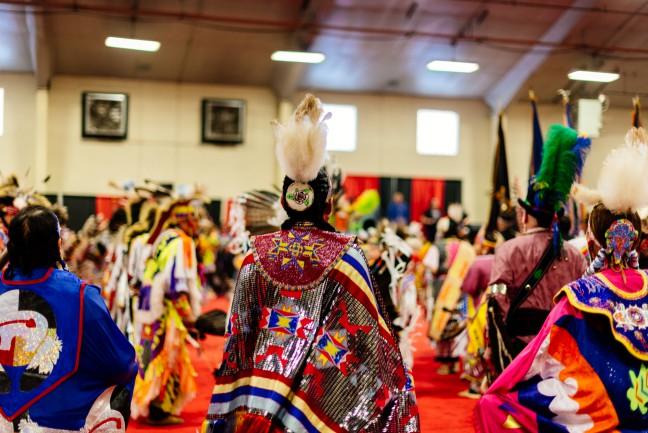Last summer, two Native American medical students approached Dr. Amy DeLong, a family physician and medical director at the Ho-Chunk House of Wellness, to tell her that she is their motivation for getting through medical school.
For DeLong, she said this is just one of many reasons why Native American representation is important in the medical field.
A recent report titled “Reshaping the Journey: American Indians and Alaska Natives in Medicine” highlighted the current racial disparities in most major medical schools. The report was conducted by the American Medical Association and Association of American Indian Physicians. Norma Poll-Hunter, senior director of Human Capital Initiatives at AMA, said there were a lot of motivations behind the report.
“This [report] was not just about … showing that there still needs to be a more concerted effort to increase the representation of American Indians and Alaska Natives,” Poll-Hunter said. “This is also to broaden understanding of the unique needs of American Indians and Alaska Natives, and also show our member institutions some exemplars of some good that’s happening that hopefully can be replicated.”
According to the report, which examined data from the last 37 years, the UW School of Medicine and Public Health has graduated only 62 students who identified as entirely or partially American Indian or Alaska Native — this out of a total of 5,481 graduates.
According to the report, these low numbers are the result of many factors, both current and historical. The report details how boarding schools in particular left lasting trauma in the Native American community.
“Boarding schools successfully stunted the transmission of cultural knowledge and fractured family structures,” the report said. “In too many cases, physical and psychological abuse from the boarding schools became internalized learned behaviors that were passed on from generation to generation, leaving individuals, families, and communities in physical, emotional, and spiritual distress.”
Programs like UW’s Native American Center for Health Professionals work to address some of these factors and encourage Native medical students. NACHP organizes family dinners and other events for Native American students to develop a sense of community on campus.
DeLong, who sits on the advising board for NACHP, said that when she was in medical school at the University of Minnesota-Duluth, a similar program helped her through. DeLong said being away from home was a culture shock, and it was beneficial to be around people with similar backgrounds.
Poll-Hunter pointed out the lack of representation as another contributor to these low numbers.
“Sometimes [Native American] students don’t have access to quality health care and may not be able to have a physician — and then not even see a physician who looks like them,” Poll-Hunter said. “So, there is a lack of connections for role models.”
This role model shortage appears to be a continuous cycle. According to AMA and AAIP’s report, there were only six medical school applicants from Wisconsin who identified as entirely or partially American Indian or Alaska Native in 2017.
DeLong explained that this shortage of Native American physicians impacts the overall health of the Native American community. In Wisconsin, Native Americans suffer great health disparities, including higher rates of heart disease, diabetes and cancer, according to the Department of Health Services.
DeLong said these disparities are impacted by a lack of reliable medical care. Many Native Americans live in rural areas, causing most physicians to stay two to three years and then leave to pursue greater economic opportunities. For people to open up to their physicians, DeLong said they need to know they are invested in the community.
“In my 13 years here, I have seen more people take charge of their health … I’ve seen the trust that I’m a stable presence,” DeLong said.
Melissa Metoxen of NACHP stressed the importance of stability. She explained that when a patient feels connected to their physician, they will share more about their overall wellbeing, thereby improving the health care they receive.
Poll-Hunter said a lack of diversity also leads to a lack of overall knowledge. When medical schools have very few Native American students, they are shielded from key health issues in the Native American community and are therefore unaware of the best practices to address those issues.
Poll-Hunter said this lack of knowledge also affects Native American students. She cited a recent report which explained that most Americans know very little about Native Americans.
“It is this invisibility that leads to a college access and completion crisis among Native American students,” the report said. “When a student is invisible, his or her academic and social needs are not met.”
DeLong suggested that increasing the representation of Native Americans in the medical field would be beneficial not only for Native American communities, but for everyone. Native American physicians are more likely to practice in rural areas, where the greatest need for physicians lies.
AMA and AAIP’s report also identified schools that have been successful in addressing the underrepresentation of Native American students, and explained some of their practices. S
Some important steps such schools have taken include developing programs like NACHP, hiring more Native American faculty, maintaining inclusive institutions, increasing visibility and actively reaching out to Native American communities.
NACHP conducts presentations in both middle schools and high schools in an effort to make connections with students early on.
DeLong emphasized the importance of this kind of active recruitment, as it’s one of the reasons she attended the University of Minnesota-Duluth. Increasing programs like NACHP to recruit and support students is essential to addressing this shortage of Native physicians, DeLong stressed.
Poll-Hunter said AMA is seeing a shortage of physicians across the nation, explaining that part of the motivation behind their report was to ensure all students who want to become physicians can.
“Really, we need to bring talent from all across different segments of our society to ensure that we’re able to meet the nation’s health care needs — and so, just on a basic level, we just need more physicians,” Poll-Hunter said.


